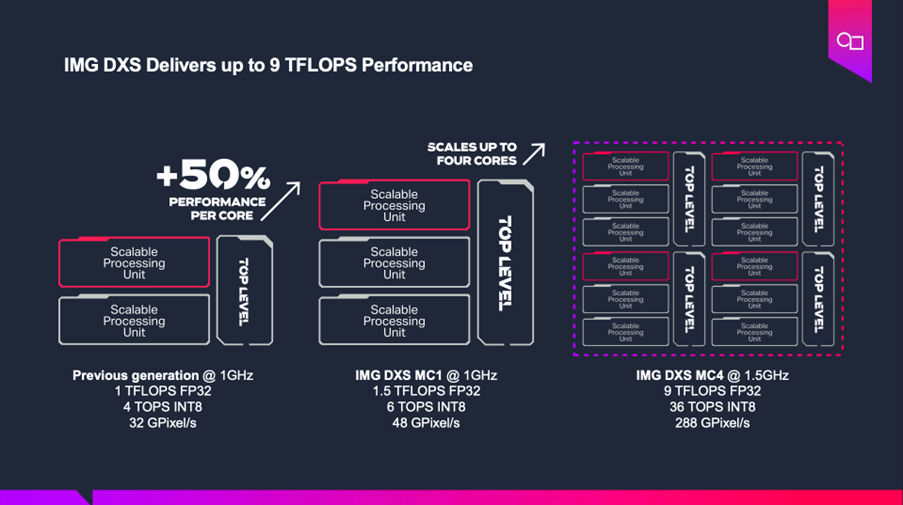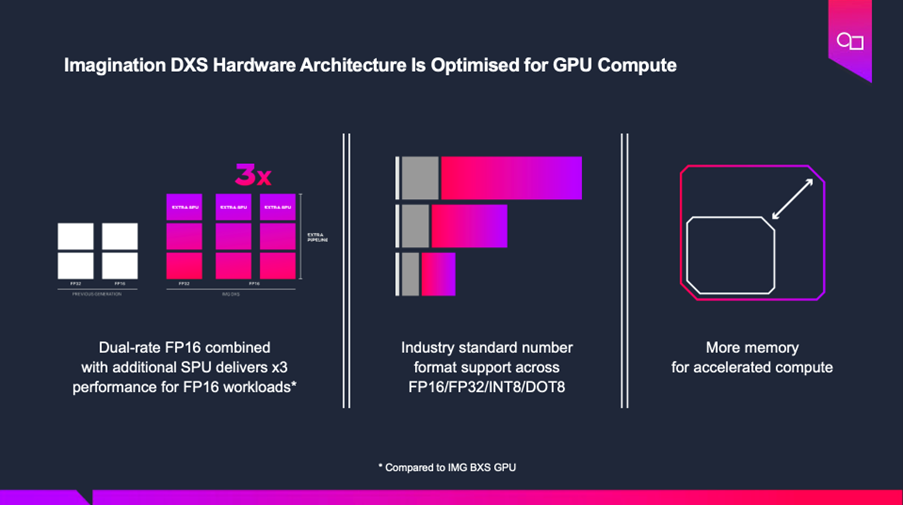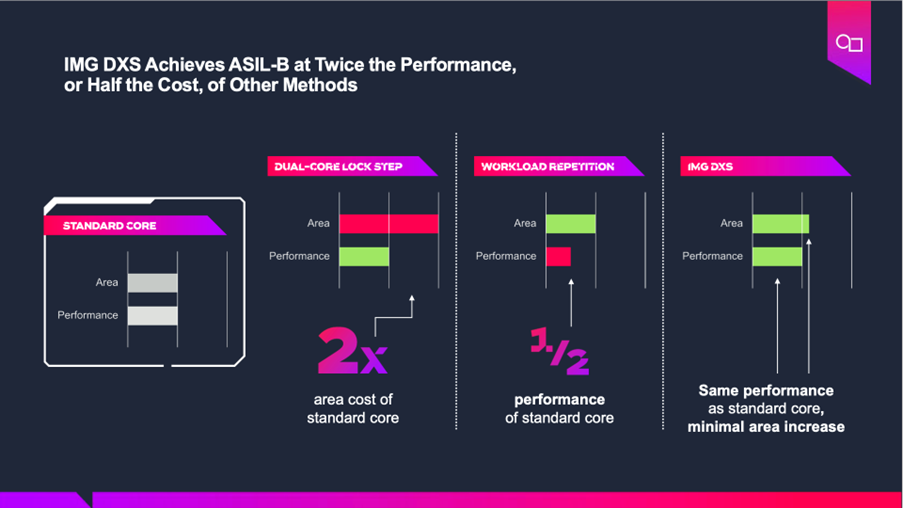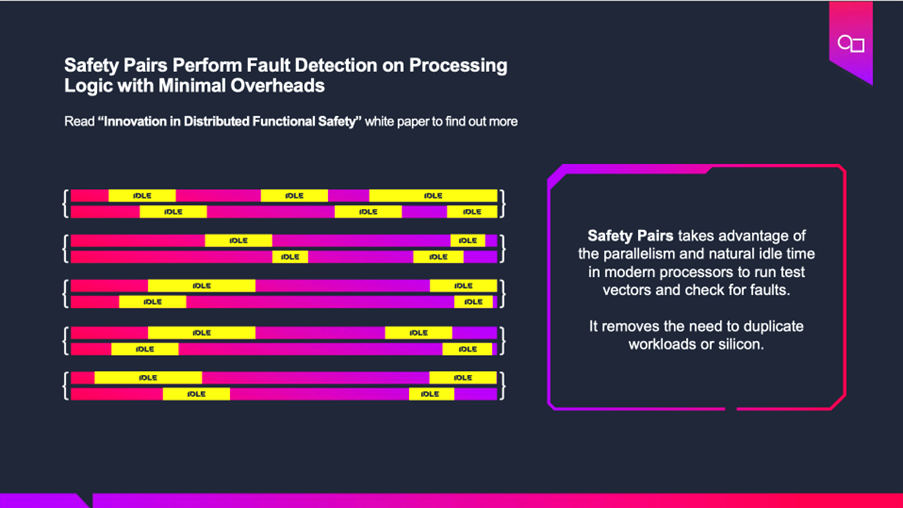Imagination Technologies has launched the DXS GPU, an automotive GPU offering 50% higher performance with up to 192 GPixel/s, 6 TFLOPS, and 24 TOPS at 1 GHz. It’s optimized for compute tasks, providing a tenfold performance increase for applications like computer vision.

The DXS targets L1/L2+ and L3 ADAS systems, positioning itself against MediaTek’s Dimensity Auto and Qualcomm’s Snapdragon Ride. It features Distributed Safety Mechanisms for ASIL-B functional safety with minimal overhead. The GPU, which supports multiple operating systems and includes new compute libraries and AI tool kits, is now available for evaluation.
What do we think? As opportunities in mobile GPU have diminished, Imagination has focused on the automotive space for some time and was the first to add certified functional safety elements. With the retirement its neural network processor (NNX), which had been licensed to a number of automotive companies for autonomy-related applications, the company needs to find an answer to the question of automotive AI. Arguably, this segment is getting more contested with relatively affordable solutions from MediaTek/Nvidia and Qualcomm, so, much probably hangs on DXS from Imagination’s point of view.
We expect that Imagination’s traditional customers in this space—large chip suppliers like TI and Renesas—will find little to object to in DXS. What is less clear is whether fear of the overall complexity of designing with GPUs is diminishing among the Tier 1 companies so that the overall market for IP in this space can grow. Reportedly, slow licensing and long time to revenue had made one Imagination competitor reconsider its automotive strategy recently, though no decisions are final about the fate of those product lines yet. If Imagination—which already has notable share so is less worried by the long period between investment and revenue—can hold on, automotive may well prove to be the linchpin of the company’s future.
DXS GPU launched for AI Hardware & Edge AI Summit
Imagination Technologies has launched the DXS GPU, its latest automotive GPU IP designed for in-vehicle intelligence and interaction. The company says DXS offers a 50% higher peak performance, with up to 192 GPixel/s, 6 TFLOPS, and 24 TOPS at 1 GHz, compared to its previous-generation automotive GPUs. At 1.5 GHz, the quoted TOPS is 36, all int8.
DXS has been optimized for compute workloads by combining the base DXS GPU with
an additional FP16 pipeline and a set of new compute libraries and AI tool kits.
This delivers a claimed tenfold increase in performance for compute workloads, with the hardware and software co-optimized for applications like computer vision and data processing.

With a typical 24 TOPS performance, DXS is not aiming for the space occupied by Nvidia’s Orin or Pegasus solutions, for which the challenger is more Intel’s new Arc A760A automotive GPU delivering up to 229 TOPS for AI operations, but rather MediaTek’s Dimensity Auto, which is very focused on infotainment. Also, Dimensity Auto probably comes below Imagination in TOPS performance and Qualcomm’s Snapdragon Ride, where performance starts at 30 TOPS for L1/L2 applications but can scale much higher for those at L3/L4. The DXS targets ADAS L1/L2+ and L3.
The increasing demand for compute power in automotive systems, including digital cockpits and ADAS, has driven the evolution of automotive GPUs from being primarily used for graphics to handling complex compute tasks. Imagination’s DXS GPU positions itself as a solution for these emerging needs, providing both safety and performance for the next generation of vehicles.

Functional safety has been an area of differentiation for Imagination, and DXS offers some innovations in that regard. Notably, DXS introduces Distributed Safety Mechanisms to deliver ASIL-B functional safety with what Imagination says is “minimal overhead” to avoid the inefficiencies of existing methods. For example, instead of dual-core lockstep, which creates more workload, DXS injects safety tests during idle moments. It’s a smart and efficient approach, but some companies have dual-core lockstep ingrained in their expectations, so Imagination will need to prove this approach.
In part, the company will do this by showing it has a minimal performance impact and area cost—Imagination estimates this at just 10%. Further details on the complete Distributed Safety Mechanisms solution can be found on the Imagination website in the whitepaper “Innovations in Distributed Functional Safety.”.

New compute libraries (imgBLAS, imgNN, imgFFT) and AI tool kits (oneAPI, TVM) are available to maximize GPU utilization and accelerate workloads for applications like ADAS systems. The software stack is based on open standards, which Imagination says will ensure portability and ease of use for developers. There may be some questions over the ongoing viability of oneAPI in light of Intel plans for cutbacks.
The DXS GPU supports multiple operating systems (e.g., BlackBerry’s QNX, Green Hills Software’s Integrity RTOS, Linux, Android) and provides hardware-based virtualization for running up to eight operating systems simultaneously. A partnership with CoreAVI is helping develop safety-critical drivers supporting graphics standards like OpenGL SC and Vulkan SC.
Imagination says the DXS range covers applications from infotainment to ADAS L3 and notes it is available for evaluation.